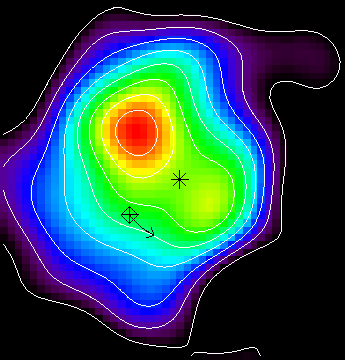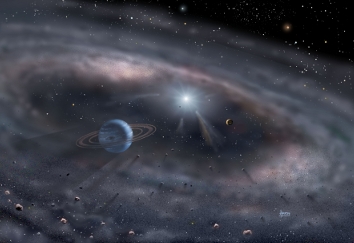A Deeper Look : Searching for life - Vega
In December 2003, modelling based on observational data was published in The Astrophysical Journal. It was based on observations taken with the world's most sensitive submillimetre camera at the time, SCUBA. The camera, built at the Astronomy Technology Centre in Edinburgh, operated on the James Clerk Maxwell Telescope in Hawaii. The SCUBA image showed a disk of very cold dust (-180 degrees centigrade) in orbit around the star.
Investigation of the distribution of material within this disk suggested something unique. Up to that point, about 100 planets had been discovered around other stars in our galaxy, but all had been 'hot Jupiter'-type planets, large and gaseous, orbiting very close to their parent stars, and therefore not very similar to our own solar system. The data from Vega however suggested the existence of a Neptune-like planet orbiting at a similar distance and with a similar mass to Neptune in our solar system. This was a substantial step towards finding potentially Earth-like planets, as the space between the newly-discovered planet and it's parent star was large enough to potentially contain small, rocky worlds similar to the smaller planets in our solar system - Mercury, Venus, Earth and Mars.
 SCUBA image with the position of the star (*) and the predicted position and
direction of the planet (x) marked. The distance between the star and the
planet is equivalent to twice that between the Sun and Neptune.
SCUBA image with the position of the star (*) and the predicted position and
direction of the planet (x) marked. The distance between the star and the
planet is equivalent to twice that between the Sun and Neptune.
Paradoxically the star barely appears in the SCUBA image because it
is far too hot to be seen with this kind of detector. Vega is, however, easily
seen with the naked eye. It is the third brightest star visible from Northern
latitudes and is bluish-white in colour.
Facts about Vega
Vega is the fifth brightest star in the sky and the third brightest
visible in the Northern hemisphere.
It is 25 light years away from the Sun (1AU is the distance between the Earth
and Sun).
It has a diameter three times bigger than the Sun.
It is 58 times brighter than the Sun.
Together with Deneb and Altair, Vega forms the summer triangle.
Vega is the brightest star in the constellation Lyra, the Harp. The
lyre, or harp, is supposed to have been invented by the Greek God
Hermes who gave
it to his half-brother Apollo. Apollo then gave it to his son Orpheus,
the musician of the Argonaughts.
Vega was the first star ever to be photographed. During the night of
July 16-17 1850 the historic picture was taken at Harvard Observatory
using a
15 inch refractor telescope during a 100 second exposure.
 An artist's impression of the disk around Vega produced by David Hardy. The modelling suggests that the Neptune-like planet actually formed much closer
to the star than its current position. As it moved out to its current wide
orbit over about 56 million years, many comets were swept out with it,
causing the dust disk to be clumpy.
An artist's impression of the disk around Vega produced by David Hardy. The modelling suggests that the Neptune-like planet actually formed much closer
to the star than its current position. As it moved out to its current wide
orbit over about 56 million years, many comets were swept out with it,
causing the dust disk to be clumpy.
Exactly the same process is thought to have happened in our Solar System, Neptune was pushed away from the Sun because of the presence of Jupiter orbiting inside it. So it appears that as well as having a Neptune-like planet, Vega may also have a more massive Jupiter-like planet in a smaller orbit.
